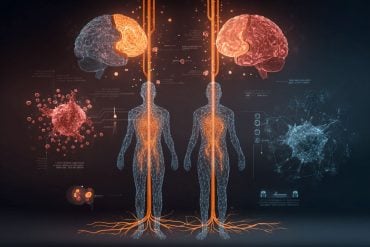Summary: New research shows that even mild, prolonged exposure to low oxygen levels can significantly disrupt the blood-brain barrier (BBB) in aging brains. Using mice aged 2 to 23 months, scientists found that older mice experienced 4–6 times more BBB breakdown than younger mice under similar hypoxic conditions.
The study also revealed increased brain inflammation in older mice, regardless of oxygen level. These findings may explain why elderly individuals with chronic respiratory or cardiovascular issues are at greater risk for neurodegeneration and cognitive decline.
Key Facts:
- Heightened Vulnerability: Aged mice showed significantly more BBB disruption at higher oxygen levels than younger mice, indicating increased sensitivity.
- Inflammation Spike: Microglial activation, a marker of brain inflammation, was elevated in older mice even under normal oxygen conditions.
- Repair Deficit: Despite steady blood vessel growth across ages, older brains exhibited impaired BBB repair, suggesting weakened vascular resilience with age.
Source: Impact Journals
In a new study, researchers Arjun Sapkota, Sebok K. Halder, and Richard Milner from San Diego Biomedical Research Institute investigated how aging affects the brain’s vulnerability to low oxygen, or hypoxia.
Using C57BL/6J mice ranging from 2 to 23 months of age, they identified specific oxygen levels that disrupt the blood-brain barrier (BBB)—a critical structure that protects brain tissue from harmful substances.

The findings are important for understanding age-related cognitive decline and the potential risks faced by individuals with chronic oxygen-limiting conditions such as asthma, sleep apnea, emphysema, and heart disease.
The BBB is essential for maintaining brain health. In this study, mild and prolonged hypoxia—called chronic mild hypoxia—was found to compromise the BBB in mice. Older mice showed significantly more BBB disruption than younger ones.
Notably, barrier weakening and blood vessel changes occurred at oxygen levels of just 15% in aged mice, compared to 13% in young mice. These data suggest that the aging brain is more sensitive to oxygen deprivation, even at levels that may be considered only mildly hypoxic.
The researchers also determined when this vulnerability emerged. The BBB showed increased sensitivity to low oxygen not only in aged mice but also in mice as young as 2 to 6 months, with a second spike occurring between 12 and 15 months—equivalent to middle age in mice.
These findings may reflect age-dependent changes in brain vascular function and remodeling capacity.
“Hypoxia-induced endothelial proliferation was relatively constant across the age range, but advanced age strongly enhanced the degree of BBB disruption (4-6-fold greater in 23 months vs. 2 months old).”
Another key focus was microglial activation, a sign of brain inflammation. Aged mice exhibited higher microglial activation across all oxygen levels, including normal conditions. Chronic microglial activation is closely linked to neuroinflammation and has been implicated in diseases such as Alzheimer’s.
While the rate of blood vessel formation was constant across ages, the degree of BBB disruption increased sharply with age, suggesting that repair mechanisms may weaken over time.
These results may help explain why older adults with chronic hypoxia-related diseases are at higher risk for neurodegeneration and cognitive decline. The study also draws attention to the risks of high-altitude exposure for aging populations, where oxygen levels naturally drop.
Altogether, these findings underscore the importance of protecting brain health in older individuals by managing oxygen exposure and reducing hypoxia-related risks. The researchers emphasize the need to develop new therapies that support blood-brain barrier integrity, particularly in aging populations exposed to chronic or intermittent low-oxygen conditions.
About this neuroscience and hypoxia research news
Author: Ryan Braithwaite
Source: Impact Journals
Contact: Ryan Braithwaite – Impact Journals
Image: The image is credited to Neuroscience News
Original Research: Open access.
“Defining the hypoxic thresholds that trigger blood-brain barrier disruption: the effect of age” by Arjun Sapkota et al. Aging
Abstract
Defining the hypoxic thresholds that trigger blood-brain barrier disruption: the effect of age
Chronic mild hypoxia (CMH; 8% O2) triggers transient blood-brain barrier (BBB) disruption, an effect greatly increased with age.
As BBB disruption predisposes to neuronal death and cognitive decline, here we defined the hypoxic thresholds that trigger BBB breakdown in young and aged mice, and then defined the age at which hypoxia-induced BBB disruption significantly increases.
Dual-immunofluorescence of brain sections demonstrated that the thresholds required to trigger hypoxia-induced BBB disruption (CD31/fibrinogen) and endothelial proliferation (CD31/Ki67) were much lower in aged mice (15% O2) compared to young (13% O2).
Hypoxia-induced endothelial proliferation was relatively constant across the age range, but advanced age strongly enhanced the degree of BBB disruption (4-6-fold greater in 23 months vs. 2 months old).
While the BBB became more vulnerable to hypoxic disruption at 12–15 months, a large step-up also occurred at the surprisingly young age 2–6 months.
Our data demonstrates that the aged BBB is far more sensitive to hypoxia-induced BBB disruption than the young and define the hypoxic thresholds that trigger hypoxia-induced BBB disruption in young and aged mice.
This information has translational implications for people exposed to hypoxia and for those living with hypoxia-associated conditions such as asthma, emphysema, ischemic heart disease, and apnea.






